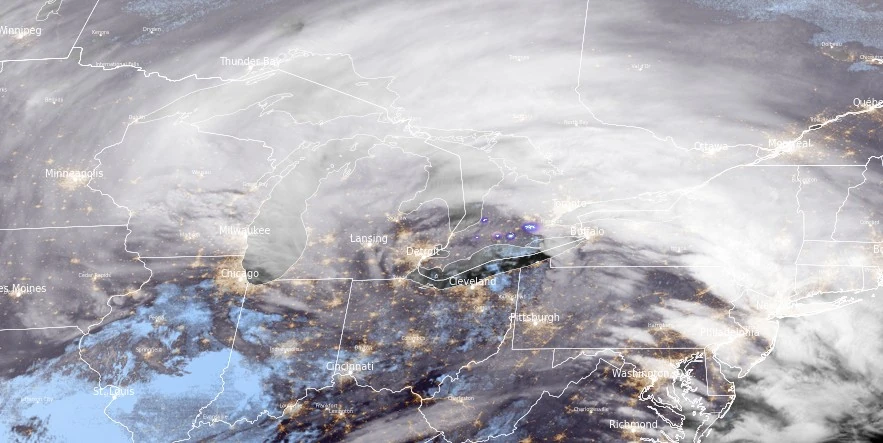Major winter storm targets Midwest to Great Lakes with heavy snow and blizzard conditions, U.S.

A powerful winter storm is set to bring heavy snow, strong winds, and blizzard conditions across the Midwest to the Great Lakes through Saturday, January 13, 2024. Following this storm, dangerously low temperatures are forecasted for the Rockies and Plains. This storm system is part of the same weather pattern that caused significant disruptions in southern Ontario, Canada.
An intense low-pressure system is bringing significant wintry weather across the Midwest to the Great Lakes, expected to last through Saturday, January 13, 2024. National Weather Service forecaster Asherman highlighted the busy weather pattern, noting that the storm will be followed by frigid Arctic air spilling southward from Canada.
As of the morning of January 13, moderate to heavy snowfall and gusty winds are reported across the Heartland. Blizzard conditions, with wind gusts of 40 – 65 km/h (25 – 40 mph), are creating dangerous travel situations across the Corn Belt through the Great Lakes. Despite the snowfall area diminishing by evening, northwesterly winds will intensify lake-effect snow downwind of the Great Lakes, with an additional 30 – 60 cm (12 – 24 inches) of snow expected in western Michigan and New York state.
In the Northeast, heavy rainfall may lead to flooding, exacerbated by recent rains. Coastal areas in the Mid-Atlantic and Northeast are also facing moderate to major coastal flooding.
Historical coastal flooding is expected in Maine on Saturday morning (LT), January 13, 2024. The state is bracing for a combination of major coastal flooding, strong winds, heavy rainfall, and snow in mountainous regions, predominantly during the morning. The most severe rain and wind conditions are forecasted between 06:00 and 10:00 LT, with the most critical coastal flooding anticipated around noon LT, coinciding with the high tide.
The western U.S. also faces severe weather conditions due to an Arctic airmass. In Montana, temperatures could drop to as low as -40 to -46 °C (40 – 50 °F). The Northern and Central Plains are likely to experience record-breaking sub-zero temperatures, with wind chill values reaching -35 °C (-30 °F) in areas extending from the northern Rockies to northern Kansas. In the Dakotas, wind chill values could plummet to around -46 °C (-50 °F).
The Great Basin and Pacific Northwest are under Winter Storm Warnings, with heavy snow and valley icing posing travel hazards. Oregon is particularly vulnerable to significant freezing rain, risking tree and power line damage. The cold air moving south is expected to bring wintry conditions to the Mid-South by Sunday, January 14, including snow, sleet, and freezing rain in the ArkLaTex region.
The hazardous weather will persist into next week, with dangerously low temperatures and wind chills. In northern coastal California and Oregon, flash flooding remains a threat with 75 – 130 mm (3 – 5 inches) of rainfall forecasted for today.
This current weather pattern across the U.S. follows the recent severe winter storm in southern Ontario, which brought heavy snow, strong winds, and widespread power outages, affecting over 30 000 homes and businesses.
The storm also severely disrupted travel, particularly at Toronto-Pearson International Airport, leading to numerous flight cancellations and delays.
This storm is prolonging a week of severe winter weather in the United States, which has already resulted in deadly avalanches and perilous ice-covered roads.
On Friday, a tragic avalanche in the Idaho backcountry is believed to have claimed a life. In Wisconsin, a man succumbed while clearing snow from his driveway. In a related incident, authorities in suburban Chicago announced the cold-related death of a man, the first of its season. Discovered on Thursday in Schiller Park, the Cook County medical examiner’s office confirmed the weather-related nature of his death, ruling it accidental.
Flight disruptions have been widespread due to the storm, with over 2 000 cancellations and more than 7 000 delays reported by FlightAware. In Idaho, an avalanche near the Montana border resulted in a rescue operation for two men on Thursday, while a third is missing and presumed deceased. The US Air Force assisted in the rescue, with the area having been under an avalanche danger warning for days. This incident followed the season’s first avalanche fatality in the US, occurring in California at a Lake Tahoe ski resort, where one person died.
In Wisconsin, the death of a 69-year-old man in Franklin, a Milwaukee suburb, is being investigated after he became unresponsive while using a snow blower.
In Michigan, the storm has led to widespread power outages. PowerOutage’s website indicates that over 184 000 customers are without electricity, as of 13:33 UTC on January 13. 91 100 customers are without power in Wisconsin, 36 900 in Ohio, 28 400 in West Virginia, and 25 000 in New York. The number of people without power keeps rising.
References:
1 Short Range Forecast Discussion – NWS Weather Prediction Center College Park MD – 328 AM EST Sat Jan 13 2024
2 Multiple fatalities as dangerous winter storm hits much of US – The Guardian – January 13, 2024
3 Major winter storm hits southern Ontario, causes blizzard conditions and power outages, Canada – The Watchers – January 13, 2024
4 Historic coastal flooding expected in Maine on Saturday, January 13, 2024 – The Watchers – January 13, 2024
5 U.S. faces first major Arctic outbreak of winter, dangerously cold wind chills expected – The Watchers – January 11, 2024
Featured image credit: NOAA/GOES-East, RAMMB/CIRA, The Watchers. Acquired at 01:00 UTC on January 13, 2024






Commenting rules and guidelines
We value the thoughts and opinions of our readers and welcome healthy discussions on our website. In order to maintain a respectful and positive community, we ask that all commenters follow these rules.